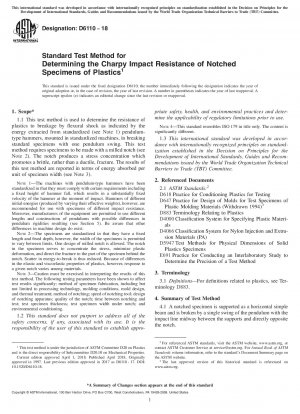ASTM D6110-18
Standard Test Method for Determining the Charpy Impact Resistance of Notched Specimens of Plastics
- Standard No.
- ASTM D6110-18
- Release Date
- 2018
- Published By
- American Society for Testing and Materials (ASTM)
- Latest
- ASTM D6110-18
- Scope
- 1.1 This test method is used to determine the resistance of plastics to breakage by flexural shock as indicated by the energy extracted from standardized (see Note 1) pendulumtype hammers, mounted in standardized machines, in breaking standard specimens with one pendulum swing. This test method requires specimens to be made with a milled notch (see Note 2). The notch produces a stress concentration which promotes a brittle, rather than a ductile, fracture. The results of this test method are reported in terms of energy absorbed per unit of specimen width (see Note 3). NOTE 1—The machines with pendulum-type hammers have been standardized in that they must comply with certain requirements including a fixed height of hammer fall, which results in a substantially fixed velocity of the hammer at the moment of impact. Hammers of different initial energies (produced by varying their effective weights), however, are recommended for use with specimens of different impact resistance. Moreover, manufacturers of the equipment are permitted to use different lengths and constructions of pendulums with possible differences in pendulum rigidities resulting (see Section 5). Be aware that other differences in machine design do exist. NOTE 2—The specimens are standardized in that they have a fixed length and fixed depth, however, the width of the specimens is permitted to vary between limits. One design of milled notch is allowed. The notch in the specimen serves to concentrate the stress, minimize plastic deformation, and direct the fracture to the part of the specimen behind the notch. Scatter in energy-to-break is thus reduced. Because of differences in the elastic and viscoelastic properties of plastics, however, response to a given notch varies among materials. NOTE 3—Caution must be exercised in interpreting the results of this test method. The following testing parameters have been shown to affect test results significantly: method of specimen fabrication, including but not limited to processing technology, molding conditions, mold design, and thermal treatment; method of notching; speed of notching tool; design of notching apparatus; quality of the notch; time between notching and test; test specimen thickness; test specimen width under notch; and environmental conditioning. 1.2 This standard does not purport to address all of the safety concerns, if any, associated with its use. It is the responsibility of the user of this standard to establish appropriate safety, health, and environmental practices and determine the applicability of regulatory limitations prior to use. NOTE 4—This standard resembles ISO 179 in title only. The content is significantly different. 1.3 This international standard was developed in accordance with internationally recognized principles on standardization established in the Decision on Principles for the Development of International Standards, Guides and Recommendations issued by the World Trade Organization Technical Barriers to Trade (TBT) Committee.
ASTM D6110-18 Referenced Document
- ASTM D4000 Standard Classification System for Specifying Plastic Materials*, 2023-03-15 Update
- ASTM D4066 Standard Classification System for Nylon Injection and Extrusion Materials (PA)
- ASTM D5947 Standard Test Methods for Physical Dimensions of Solid Plastics Specimens
- ASTM D618 Standard Practice for Conditioning Plastics for Testing*, 2021-07-15 Update
- ASTM D647 Standard test method for determining the wrinkle resistance of fabrics used in inflatable restraints
- ASTM D883 Standard Terminology Relating to Plastics*, 2024-02-01 Update
- ASTM E691 Standard Practice for Conducting an Interlaboratory Study to Determine the Precision of a Test Method
ASTM D6110-18 history
- 2018 ASTM D6110-18 Standard Test Method for Determining the Charpy Impact Resistance of Notched Specimens of Plastics
- 2017 ASTM D6110-17 Standard Test Method for Determining the Charpy Impact Resistance of Notched Specimens of Plastics
- 2010 ASTM D6110-10 Standard Test Method for Determining the Charpy Impact Resistance of Notched Specimens of Plastics
- 2008 ASTM D6110-08 Standard Test Method for Determining the Charpy Impact Resistance of Notched Specimens of Plastics
- 2006 ASTM D6110-06 Standard Test Method for Determining the Charpy Impact Resistance of Notched Specimens of Plastics
- 2005 ASTM D6110-05a Standard Test Method for Determining the Charpy Impact Resistance of Notched Specimens of Plastics
- 2005 ASTM D6110-05 Standard Test Methods for Determining the Charpy Impact Resistance of Notched Specimens of Plastics
- 2004 ASTM D6110-04e1 Standard Test Methods for Determining the Charpy Impact Resistance of Notched Specimens of Plastics
- 2004 ASTM D6110-04 Standard Test Methods for Determining the Charpy Impact Resistance of Notched Specimens of Plastics
- 2002 ASTM D6110-02 Standard Test Methods for Determining the Charpy Impact Resistance of Notched Specimens of Plastics
- 1997 ASTM D6110-97 Standard Test Methods for Determining the Charpy Impact Resistance of Notched Specimens of Plastics
